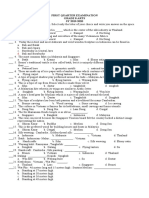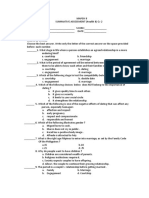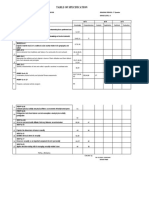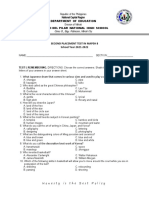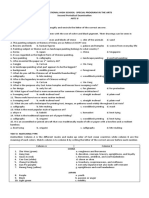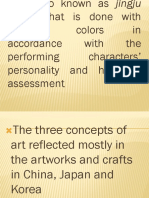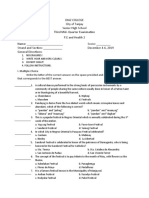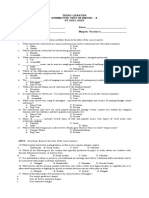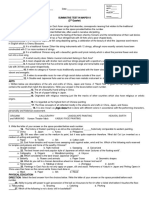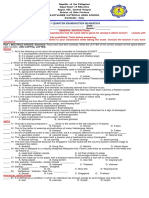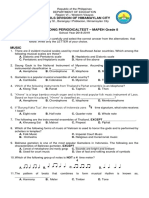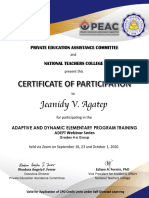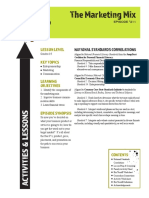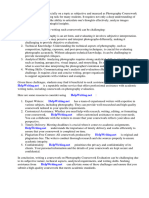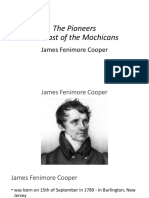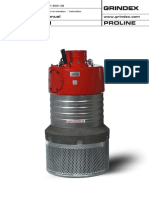2nd Monthly EXAM MAPEH 8
Uploaded by
Jenidy Vega-Agatep2nd Monthly EXAM MAPEH 8
Uploaded by
Jenidy Vega-Agatep2ND QUARTERLY EXAMINATION
MAPEH 8
NAME: __________________________________ DATE: 09/19/19
YEAR & SEC: 8-B Teacher:
TEST I. MULTIPLE CHOICE. Select only the letter of your choice and write you answer on the space
before each number.
___ 1. Thai silk is mainly produced in _____ which is the center of the silk industry in Thailand.
a. Takeo b. Khorat c. Kampot d. Ha Dong
___ 2. This is the center of weaving and sericulture of the many Vietnamese fabrics.
a. Takeo b. Khorat c. Kampot d. Ha Dong
___ 3. This is lute pear-shaped instrument with four or five strings and frets made of wood.
a. Biwa b. Shamisen c. Sho d. Ryuteki
___ 4. The most common fabric in Malaysia and Singapore.
a. Batik b. Krama c. Sihn d. Ebony satin
___ 5. This is a long-necked plucked instrument with three strings played with a bow, this has no frets.
a. Biwa b. Shamisen c. Sho d. Ryuteki
___ 6. These are made up of rice paper with a bamboo frame which contains a fuel cell or small
candle.
a. Flying carpet b. Flying lantern c. Wayang kulit d. Wau kite
___ 7. A type of puppet shadow play performed around the Indo – Malayan Archipelago.
a. Flying carpet b. flying lantern c. Wayang kulit d. Wau kite
___ 8. This is a type of cap from Brunei which is made from velvet.
a. Sihn b. dastar c. tangkolok d. songkok
___ 9. A Malaysian kite wherein its wings are similar to Arabic letter.
a. Songkok b. Flying lantern c. Wayang kulit d. Wau kite
___10. A men’s head gear for Muslims which is a piece of cloth tied around the head.
a. Sihn b. Dastar c. Tangkolok d. Songkok
___11This is a short bamboo doubled-reed pipe with nine fingerholes.
a. Biwa b. Shamisen c. Sho d. Hichiriki
___12. This is a set of seventeen bamboo mouthpipes.
a. Biwa b. Shamisen c. Sho d. Ryuteki
___13. This is a flute instrument.
a. Biwa b. Shamisen c. Sho d. Ryuteki
___14. It is a plucked table zither instrument with thirteen strings.
a. Biwa b. Hichiriki c. Koto d. Sho
___15. It is an end-blown five-fingerhole flute
a. Shakuhachi b. Shamisen c. Biwa d. Koto
___16. Silk weaving : Cambodia ; Golden thread silk : _____________
a. Indonesia b. Malaysia c. Vietnam d. Thailand
___17. Batik : Indonesian- Malay ; _______________ : Vietnam
a. Handicrafts b. Sihn c. Silk weaving
d. Ebony satin
___18. Wayang kulit: Ramayana ; Tangkolok: _________
a. Songkok b. Dalang c. Flying lantern d. Sa
___19. Handicraft : Cambodia ; Silk painting : _______________.
a. Brunei b. Vietnam c. Indonesia d. Thailand
___20. Dalang : ____________; Kopiah : Songkok
a. Wau kite b. Wayang kulit c. Sa d. Dastar
___21. Kettledrum : Vietnam ; Wat Pho :_______.
a. Thailand b. Laos c. Singapore d. Brunei
___22. Wat Pho : 46 meters long and 15 meters high : Sentosa Merlion : __________________
a. Standing at 37 meters high
b. Standing at 30 meters high
c. Standing at 36 meters high
d. Standing at 40 meters high
___23. The Lao women’s ankle long skirt whose form is undeniable but whose patterns are unique is
called_____.
a. Silk worm b. Krama c. Sihn d. Ebony satin
___24. Golden thread silks were born in Vietnam. Many of our Vietnamese fabrics from Ha Dong the
center of Weaving and __________.
a. Batik b. Sericulture c. Ikat Techniques d. Stone carving
___25. Wau kite in Malay is a uniquely designed Malaysian kite. Farmers used kites as a scarecrow in
the fields and as a means to___________.
a. Keep their children awake
b. Scare their children
c. Lull their children to sleep
d. Encourage children to work.
___ 26. This was regarded as the highest form of Chinese painting.
a. Landscape painting
b. Palaces and temples
c. Human figures
d. Bamboos and stones
___ 27. History of Eastern painting is as old as the civilization of
a.North Korea b. Japan c. South Korea d.China
___ 28. Chinese is known for being artistic. For them, this is the art of beautiful handwriting.
a. Logographs b. Calligraphy c. Hieroglythics d. Woodblock
printing
___ 29. A technique for printing text, images or pattern which originated in China as a method for
printing on paper.
a. Logographs b. Calligraphy c. Hieroglythics d.Woodblock printing
___ 30. Paper was first invented by _________ of the Eastern Han Dynasty in China
a. Cangie b. Wei Fang c. Lun Ty d. Cai Lun
___ 31. This is a traditional Japanese art of paper folding.
a. Calligraphy b. Origami c. Jianzhi d. Mundi
___ 32. The best known and most popular style of Japanese art
a. Calligraphy b. Origami c. Jianzhi d. Ukiyo – e
___ 33. Painting subjects or theme of Japan is usually
a. Landscape painting
b. Palaces and temples
c. Scenes from everyday life
d. Flowers and birds
___35. The goal of this art is to transform a flat sheet of paper into a finished sculpture through folding
and sculpting technique without cutting as much as possible.
a. Calligraphy b. Origami c. Jianzhi d. Mundi
TEST II.
Choose the correct answer inside the box.
Shooting --------Dribbling---------Passing--------Rebounding------Running
________36.Do not use the whole hand to avoid losing control of the ball.
________37.Spread your fingers to allow full control of the ball as itdribbles.
________38.Concentrate and be relaxed on the basket.
________39.Wear a good pair of playing shoes.
________40.Practice good footwork as well as your vertical leaps or jumps.
________41.If you are a hard shooter, there is little or no arc on your shots or the ball bounces far from
the ring.
________42.In every passing that follows through, the ball will have a backspin to it.
________43.Be relaxed when shooting free throws.
________40.Jump naturally by doing “Up! Hang! Shoot!’
________45.Use the wrist and the forearm to push the ball while covering the court.
________46.Focus and anticipate where the ball will land.
________47.A good pass is a pass that a teammate can catch.
________48.Have an arc on every shoot you take.
________49.Dribble the ball on one side of your body and not right in front.
________50.Do warm-up and a dynamic streching.
TEST III. ESSAY:5 POINTS EACH
CRITERIA;
CONTENT-3
ORGANIZATION-1
CLEANLINESS-1
1. It is necessary to undergo courtship? Why or why not?
2. When do you say that a marriage is successful? Explain
Prepared by: Checked by:
Jeanidy V. Agatep Jemimah G. Bareo,LPT
Subject Teacher Academic Coordinator,SHS
Approved by:
Willy A. Panaga Jr., LPT
Principal, H.S Department
You might also like
- Local Anaesthetic Doses Guidance - NCH Only100% (1)Local Anaesthetic Doses Guidance - NCH Only2 pages
- MAPEH ARTS 8 First To Fourth Quarter Examination78% (18)MAPEH ARTS 8 First To Fourth Quarter Examination8 pages
- Mapeh Grade 8 1 Quarter Examination: T'ai ChiNo ratings yetMapeh Grade 8 1 Quarter Examination: T'ai Chi2 pages
- Q2 G8 Second Placement Test in Mapeh 8 2021-2022No ratings yetQ2 G8 Second Placement Test in Mapeh 8 2021-20226 pages
- Mapeh 7 Third Quarter Summative Test: Music100% (1)Mapeh 7 Third Quarter Summative Test: Music3 pages
- Of Sapang Dalaga Inc.: First Periodical Examination Mapeh 8No ratings yetOf Sapang Dalaga Inc.: First Periodical Examination Mapeh 83 pages
- Misamis Occidental National High School Third Quarter Summative Test 2 in Mapeh 8 Sy 2020-2021No ratings yetMisamis Occidental National High School Third Quarter Summative Test 2 in Mapeh 8 Sy 2020-20213 pages
- Learning Activity Sheet in Mapeh 8 (Arts) Third Quarter - Week 3 and 4 INo ratings yetLearning Activity Sheet in Mapeh 8 (Arts) Third Quarter - Week 3 and 4 I8 pages
- MAPEH ARTS 7 First To Fourth Quarter Examination50% (2)MAPEH ARTS 7 First To Fourth Quarter Examination9 pages
- I. Multiple Choice Write The Letter of The Correct Answer On The Space Provided and Underline The Letter That Corresponds To The BEST AnswerNo ratings yetI. Multiple Choice Write The Letter of The Correct Answer On The Space Provided and Underline The Letter That Corresponds To The BEST Answer3 pages
- Score:: Division of Taguig City and Pateros Diosdado Macapagal High School Unit Test Mapeh Grade 8No ratings yetScore:: Division of Taguig City and Pateros Diosdado Macapagal High School Unit Test Mapeh Grade 85 pages
- Fourth Periodical Examination Mapeh 7 Name: Grade & Sec.: ScoreNo ratings yetFourth Periodical Examination Mapeh 7 Name: Grade & Sec.: Score4 pages
- Unit Standards and Competencies Diagram: BIT International College Poblacion Jagna, BoholNo ratings yetUnit Standards and Competencies Diagram: BIT International College Poblacion Jagna, Bohol5 pages
- Department of Education: Republic of The PhilippinesNo ratings yetDepartment of Education: Republic of The Philippines3 pages
- First Grading Examination in Mapeh 7 Sy. 2021-2022No ratings yetFirst Grading Examination in Mapeh 7 Sy. 2021-20227 pages
- Second Quarter Examination Mapeh 10 Arts S.Y 2017-2018 Table of SpecificationNo ratings yetSecond Quarter Examination Mapeh 10 Arts S.Y 2017-2018 Table of Specification2 pages
- Department of Education: 4 Quarterly Test For MAPEH 8100% (1)Department of Education: 4 Quarterly Test For MAPEH 83 pages
- Agatep - ADEPT Certificate of Participation - Grades 4-6 - Wsig PDFNo ratings yetAgatep - ADEPT Certificate of Participation - Grades 4-6 - Wsig PDF1 page
- Applied Economics 11: Answer For Each Item. STRICTLY NO ERASURES ALLOWED100% (1)Applied Economics 11: Answer For Each Item. STRICTLY NO ERASURES ALLOWED4 pages
- Choose The Correct Answer Inside The BoxNo ratings yetChoose The Correct Answer Inside The Box6 pages
- DM No. 074, S. 2018 Annual Ranking For Vacancies To Teacher II and Teacher III For School Year 2018-2019 PDFNo ratings yetDM No. 074, S. 2018 Annual Ranking For Vacancies To Teacher II and Teacher III For School Year 2018-2019 PDF12 pages
- Mid Term Test 1 A.: 1. Rony: Finally, I've Finished Polishing My Shoes. What Do You Think? TinaNo ratings yetMid Term Test 1 A.: 1. Rony: Finally, I've Finished Polishing My Shoes. What Do You Think? Tina8 pages
- Constract, Specification and Quantity SurveyingNo ratings yetConstract, Specification and Quantity Surveying72 pages
- Suicidal Risk Assessment - Becks Suicide Intent Scale100% (3)Suicidal Risk Assessment - Becks Suicide Intent Scale3 pages
- The Pioneers The Last of The Mochicans: James Fenimore CooperNo ratings yetThe Pioneers The Last of The Mochicans: James Fenimore Cooper18 pages
- United States Bankruptcy Court Southern District of New YorkNo ratings yetUnited States Bankruptcy Court Southern District of New York20 pages
- 3republic of Tbe Bilippines: Upreme (OurtNo ratings yet3republic of Tbe Bilippines: Upreme (Ourt17 pages
- PDF Mosby s Pharmacology Memory NoteCards Visual Mnemonic and Memory Aids for Nurses 3rd Edition Joann Zerwekh download100% (8)PDF Mosby s Pharmacology Memory NoteCards Visual Mnemonic and Memory Aids for Nurses 3rd Edition Joann Zerwekh download85 pages
- HLT7036 Research Methods Portfolio Assessment Brief 22-23No ratings yetHLT7036 Research Methods Portfolio Assessment Brief 22-236 pages
- Division of Bohol: Republic of The Philippines Department of Education Region VII, Central VisayasNo ratings yetDivision of Bohol: Republic of The Philippines Department of Education Region VII, Central Visayas3 pages
- Passenger Car Units (PCU) Analysis: Name of Road: Length: 6.5 KMNo ratings yetPassenger Car Units (PCU) Analysis: Name of Road: Length: 6.5 KM3 pages





